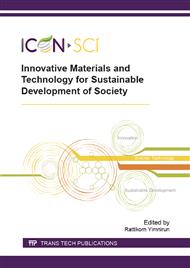p.3
p.7
p.12
p.16
p.21
p.25
p.30
p.34
Design of Experiments for (100) Si Vertical Wall Wet Etching Using Sonicated NaOH Solution
Abstract:
Silicon-based thermoelectric device fabricated using standard semiconductor manufacturing technique is a promising technology that could lead to a mass production of clean energy. The vertical wall fabrication on Si substrates is typically achieved by high cost plasma etching and involved hazardous gases. The proper wet etching condition offers an economically alternative method in obtaining vertical wall on the Si substrate. Experimental trials were conducted by design of experiments (DOE) technique to find an anisotropic wet etching condition that achieves vertical etched wall on (100) Si wafer. Three considered factors assigned to the DOE were NaOH concentration, solution temperature, and IPA addition. The response aimed for this study was not only targeting at 90° wall but also providing highest etch rate. The experimental results showed that in order to get the 90° wall, the best etching condition achieved was using 45% wt of NaOH concentration, 40°C solution temperature, and without IPA added. This condition gave an etch rate of 97.11 nm/min with surface roughness (Ra) of 10.58 nm.
Info:
Periodical:
Pages:
12-15
Citation:
Online since:
October 2015
Authors:
Keywords:
Price:
Сopyright:
© 2015 Trans Tech Publications Ltd. All Rights Reserved
Share:
Citation:


